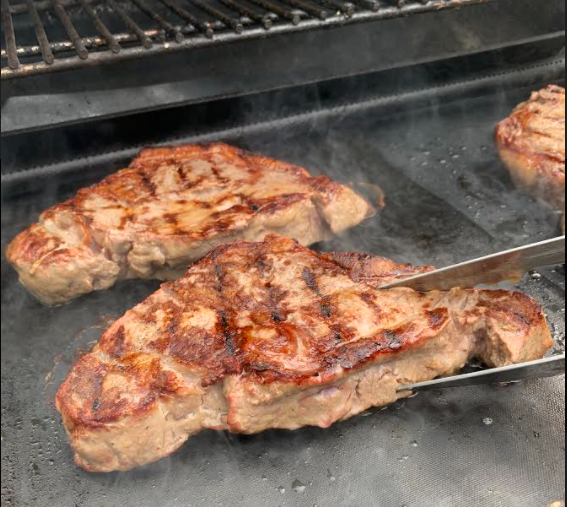This regular column on tips to live more sustainably comes from the 52 Weeks Climate Action Challenge. The challenge was created by Laurel Hood and Sherri Jackson. Hood is a retired Collingwood Collegiate Institute teacher, and Jackson is a writer and speaker, and ran as the Green Party’s candidate for the area in the last federal election. Both are climate activists.
*****
In the immortal words of Pink Floyd, how can you have any pudding if you don’t eat your meat? It’s a good question. Meat has been a staple in the Western diet for a really long time. It used to be a luxury. Now, it’s a requirement for many of us.
The debate rages on – is vegetarianism better for you, or is it okay to be a carnivore? Well, I’ll leave all that up to you to decide for yourself. Depending on your initial premise, you can google “is vegetarianism bad” or “is vegetarianism good” and you’ll get two (mostly) logical, yet opposing views. So, let’s leave the ethics and the health out of it for now. We’re focusing on climate change, and what we can do to counteract it. And, I’m sorry to say, the target is on meat as a big player in the pollution game.
Worldwide over the past 50 years, as we have made tremendous advances in some ways, meat consumption has quadrupled to over 320 million tonnes per year! As we’ve discussed, meat production requires massive resources, like water, land, and feed, which has to be grown on even more land, requiring even more water.
Animal agriculture is the second-worst culprit of human-generated carbon emissions, contributing about 20 per cent of the world’s greenhouse gases. Animals produce 30-40 per cent of the world’s methane emissions, and much of that is in how factory farms raise their animals, the sheer number of animals raised, and the prevalence of cheaper feed (like corn) which is not a normal part of their diet. Hence, the reason cows get a bad rap. It’s not their fault really – they were designed properly by nature, and they were domesticated for centuries before big business figured out a way to exploit them, and it all went downhill from there.
Farming sustainably is a game changer, and animals are a big part of that cycle. If all our meat was sustainably raised, it would be a different conversation. But, right now, the majority of our meat comes from factory farms. And that’s a problem.
Don’t believe me, or perhaps you don’t want to believe me? Then here we go.
Challenge 30: Calculate your meat footprint.
Visit https://www.omnicalculator.com/ecology/meat-footprint.
This challenge isn’t for the faint-hearted. This site calculates how much water is consumed to produce the meat you eat, and the carbon dioxide equivalency of the emissions produced from that meat. I’ll level with you. It’s pretty disturbing.
If that wasn’t enough, it also lays it out in clear terms, like, “your meat consumption is the CO2 equivalency of x number of cell phone charges, y number of litres of gas.” You get the picture.
After you’ve recovered from your meat footprint analysis, see if you can make some changes to improve your score. See if you can go one week without beef or lamb – these are the most carbon-intensive meats.
It takes over 15,000 litres of water to raise one kilogram of beef. It produces the equivalent of 85.2 kg of CO2, and needs 326 m2 of land use. For one kilogram! There are 320 billion kgs of meat consumed annually. It’s mind-boggling. Lamb takes 10,400 litres. So, if you can reduce your consumption of these two, you’re having an impact.
If you haven’t watched the documentary Cowspiracy yet then watch it this week. It’s available on Netflix.
If you really want to dive into some data, you can check out the Climate Change and the American Diet Report by the Yale Program on Climate Change Communication. It has some interesting statistics on why we eat the way we do, what our preconceived notions are, and a ton more statistics in its 44-page findings.
So, can you adopt different habits? That’s the question. Can you eat less red meat? Can you source your meat from places that farm more sustainably? Can you eat more plant-based proteins? Can you try meatless Mondays?
Again we are at the place where we have to reassess whether what we’ve been doing is working for us. Times are a-changin'. Maybe factory farming was sustainable for a number of years, but, we’re coming to the end of its feasibility. We’re going to have to look at new ways of doing things if we’re going to survive. Yeah, I know that’s a bleak statement.
There are so many ways that modern farming can become the hero in the climate change story, by adopting more sustainable farming practices, which not only help the planet, but improve the health of the farm’s soil, which improves yields, requires less chemical pesticides and fertilizers, and, oh, yeah, sequesters massive amounts of carbon at the same time.
It’s a myth that sustainable practices aren’t as productive as conventional ones. Watch Kiss the Ground on Netflix, which connects the dots between healthy soil and healthy humans. Even possibly, whether there will be humans in the future.
Throughout history, agriculture has evolved to meet the needs of the planet, and the lifeforms on it. When conditions shift, farmers are ready to tackle new challenges as they arise. So here we are, in the biggest challenge of history. The fight for the survival of our planet and our species. What do we do in the face of that? Time will tell.
***********************



